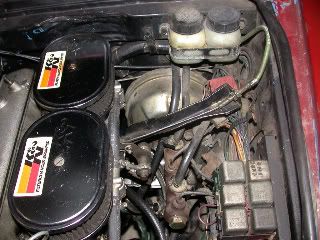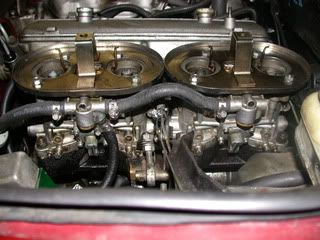
The car sat for ~5 years before I purchased it. After I purchased the car I disassembled the carbs and cleaned them up. They seem to run well now, except for idling. I've got the throttle screws turned in all the way. The mixture screws don't seem to have a strong effect on idling. Once the engine is warmed up it idles fairly well at around 1100 RPM but when it's cold it stalls unless you keep it going with some pressure on the accelerator. I'm getting over 20MPG and the engine runs well on the road so they must be operating close to okay. I've developed an accelerator pump drip on the front carb (they still have red diaphragms) so now I've ordered a rebuild kit. I'll be taking these apart again. I plan to note the sizes of all the jets. I'll make sure the idle circuits are clear.
Here's my questions:
1. I really don't like the throttle linkage connection (green cable in the photo). The cable is jammed against the side of the engine bay. I plan to cut the bracket and weld it so the cable connection is closer to the carbs. Any comments?
2. Do I absolutely need a synchrometer to tune these and keep them working? It appears that to use the meter you jam it down the air horns. My setup doesn't have air horns--I suppose for clearance issues. How would I get a synchrometer to work with my setup?

3. My engine vacuum advance is not connected. Where would be the best place to connect it? The brakes get their vacuum from a connection on the intake manifold. Should I connect the VA there?
4. The carbs 'start assist' mechanisms are not connected. I was thinking about connecting them to a cable and routing it through the firewall to the throttle knob mounted below the dash. It would help when then engine is cold. Comments?
Thanks for your help.
-Jerry